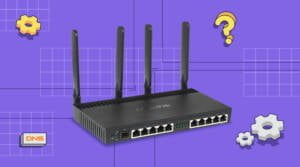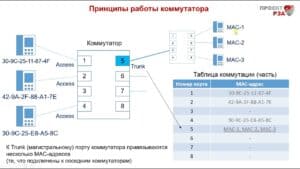- The importance of a router in modern networks
- How to Set Up a Wi-Fi Router: Step by Step
- Which router brands are leading the market?
- Frequently asked questions about the Wi-Fi router
- What is the cost of a Wi-Fi router?
- Can I use the router without the Internet?
- How do you know if your router needs replacing?
The importance of a router in modern networks
A Wi-Fi router is a device that is used to transfer data between different devices on a network. It plays an important role in modern networks, as it allows you to connect multiple devices into one network and provides stable and fast data transfer. In the modern world, when many people work from home and often use multiple devices such as laptops, tablets and smartphones for work and entertainment, a Wi-Fi router becomes an integral part of life. It provides wireless access to the Internet and allows you to connect to the network even when the devices are at a great distance from the router. Wi-Fi routers can be used both in home networks and in offices and other companies. They ensure network security, thanks to the data encryption function and protection against hacking. In addition, they can be used to configure network settings and control access to the Internet. In summary, we can say that a Wi-Fi router is an important component in modern networks. It provides fast and stable data transfer, allows you to connect multiple devices into one network and ensures network security. A Wi-Fi router is a device that provides an Internet connection. Its main function is to route data between the local network and the Internet. Wi-Fi routers operate on wireless standards such as Wi-Fi and can connect to the Internet via a wired connection such as Ethernet.
When a user sends a request to access the Internet, the Wi-Fi router receives it and forwards it to the ISP's server. After receiving a response from the server, the router sends the data back to the local network, where it can be received by devices connected to the Wi-Fi network.
Routers can also perform other functions, such as filtering traffic, setting up a wireless network, and controlling Internet access. They may also have additional features such as VPN support or firewall settings.
There are many different models of Wi-Fi routers, and choosing a specific model depends on the user's requirements. However, when choosing a router, you need to make sure that it supports the Wi-Fi standards that are used on the local network.
Overall, a Wi-Fi router is an important device that allows users to access the Internet and connect to a local network. It performs many functions that ensure the security and ease of use of the network.
A Wi-Fi router is a device that allows you to connect multiple devices to the Internet at the same time via a wireless connection. It has several basic features that allow it to work.
The first function is to receive a signal from an Internet provider and transmit it wirelessly. This allows you to connect several devices to the Internet at the same time, such as a smartphone, laptop or tablet.
The second function is to create a wireless Wi-Fi network and protect it from unauthorized access. The router has the ability to encrypt data transmitted over the wireless network to protect it from intruders.
The third function is to manage traffic on the wireless network. The router can determine which devices are accessing the Internet and control the data transfer rate for each device.
The fourth function is to provide access to a local network. The router can connect to a local network, which allows you to connect other devices to it, such as printers, network storage, or smart home devices.
A Wi-Fi router is an important device that provides access to the internet and creates a wireless network. It has several features that allow it to work and ensure the security of wireless data transmission.
How to Set Up a Wi-Fi Router: Step by Step
Setting up a Wi-Fi router is not difficult, but it does require some knowledge and skills. By following the steps below, you will be able to configure your Wi-Fi router yourself:
1. Connect your router to your ISP and computer using Ethernet cables.
2. Enter the router's IP address into your browser's address bar. Usually it's 192.
168.
1.
1 or 192.
168.
0.
1.
3. Enter your username and password to access the router settings. If you do not know your username and password, check the documentation for your router or contact your Internet provider.
4. Set up Wi-Fi security by setting a password to access the network. This will help protect your network from unauthorized access.
5. Set up the Wi-Fi network name (SSID) so that it can be easily identified.
6. Set up the Wi-Fi channel. It is recommended to select the channel that is least crowded in your area.
7. Configure access filters to deny network access to certain devices.
8. Configure router ports to forward traffic to specific devices on the network.
By following these simple steps, you can set up your Wi-Fi router and enjoy a fast and secure internet connection. If you want to set up Wi-Fi in your home or office, then you've most likely already been faced with the need to choose a Wi-Fi router. It is a key component of your network that manages the flow of data and provides access to the Internet.
There are several factors to consider when choosing a router for your needs. First of all, you must decide on the technical characteristics of the device, such as data transfer speed, signal range and the number of connected devices.
It is also worth paying attention to the functionality of the router. Some models have a parental control feature that allows parents to control network access and limit the amount of time their children can use the Internet. Other routers may have a VPN feature that allows you to access the Internet securely from anywhere in the world.
Finally, don't forget about the brand and price of the device. Popular brands like Cisco, TP-Link, and Asus usually offer reliable, high-quality routers, but they can also be more expensive than lesser-known brands.
Ultimately, choosing a Wi-Fi router depends on your needs and budget. Before buying, it is recommended to conduct market research and read user reviews of a specific model. A Wi-Fi router is a device that allows you to connect multiple devices to the Internet at the same time. The main function of a router is to route traffic on the network. It determines which path the data must take to reach the desired device on the network.
The main characteristics of a router are data transfer speed, number of ports, Wi-Fi standard support, customization options, and security. Depending on your needs, you can choose a router that supports one or more Wi-Fi standards, such as 802.
11n, 802.
11ac and 802.
11ax.
It is also important to pay attention to the number of ports on the router. The more ports, the more devices you can connect to the network. The presence of USB ports allows you to connect an external drive and use it as a network drive.
Setting up a router is an important step in its installation. A good router should have a user-friendly setup interface. It should allow you to change network parameters such as SSID and password, set up traffic filtering, and manage network access.
Security is another important aspect when choosing a router. A good router should support WPA2-PSK, as well as other encryption methods. It should also provide protection against password hacking and network attacks.
It's important to choose a router that suits your needs. It must have the necessary characteristics to connect all devices on the network, as well as provide security and ease of configuration.
Which router brands are leading the market?
There are many Wi-Fi router manufacturers on the market, but some of them are leaders in sales and popularity. Among these brands are:
- Asus;
- TP-Link;
- Netgear;
- D-Link;
- Linksys.
Each of these brands provides a wide selection of routers to suit different needs and budgets. However, when choosing a router, you need to take into account not only the brand, but also the technical characteristics of the device, such as data transfer speed, number of ports and Wi-Fi signal range.
Frequently asked questions about the Wi-Fi router
A Wi-Fi router is a device that allows you to create a wireless network and connect various devices to it. But how does a router work and what problems can arise when using it? Let's understand some frequently asked questions.
- What should I do if my device does not connect to Wi-Fi?
In this case, you first need to check whether the network password is entered correctly. If the password is correct, you can try rebooting the router and the device that is not connecting.
- How to find out the password for a wireless network?
The password can be found on the router itself or in the Wi-Fi network settings on your computer or smartphone.
- What to do if Wi-Fi is slow?
First of all, you need to check if there are other devices that are loading the network. If all devices are on the same network, you can try rebooting the router or using a more powerful router.
- How to protect your wireless network from unauthorized access?
To protect your Wi-Fi network from unauthorized access, you need to use a password and configure data encryption.
It is important to remember that proper configuration and use of a Wi-Fi router will allow you to create a stable and secure wireless network that will work without failures.
What is the cost of a Wi-Fi router?
A Wi-Fi router is a device that allows you to create a wireless network to connect multiple devices to the Internet at the same time. The cost of a Wi-Fi router can vary depending on its features and manufacturer. However, on average, the cost of such devices on the market starts from 1000 rubles and can reach several thousand rubles for more advanced models.
It is worth noting that when choosing a Wi-Fi router, you should not look only at the price. It is also important to take into account such parameters as data transfer speed, network coverage, number of antennas and other technical characteristics. By choosing a quality device, you can enjoy stable and fast operation of your wireless network.
Can I use the router without the Internet?
Yes, the router can be used without the Internet. It can be used to create a local network, which allows you to connect multiple devices to it and exchange data between them. In this case, the router acts as a switch.
To create a local network, you need to connect the router to a wired network, such as an Ethernet cable, and connect several devices to it, such as computers, printers, or storage devices. The router automatically assigns addresses to devices on the network, allowing them to communicate.
The router can also be used to create a Wi-Fi network without Internet access. In this case, devices connected to the network can communicate with each other, but cannot access the Internet.
Thus, a router is a useful device that can be used to create a local network without Internet access.
How do you know if your router needs replacing?
Like any technical device, a Wi-Fi router can break down over time and require replacement. But how do you understand what exactly is not working and whether the router itself needs to be replaced?
The main signs that the router needs to be replaced:
1. Low Internet speed. If you notice that the speed of loading pages on the Internet is significantly slower than before, then this may be a sign that the router cannot cope with the load and needs to be replaced.
2. Periodic malfunctions. If your router periodically reboots or disconnects from the network, this may be a sign that the device is failing and needs to be replaced.
3. Problems with Wi-Fi. If you have problems connecting to a Wi-Fi network or the data transfer speed via Wi-Fi is significantly lower than through a cable connection, then most likely the reason is a faulty router.
4. Outdated equipment. If your router has not been updated for a long time and does not support new technologies, then most likely its functionality is already outdated and needs to be replaced with a new device.
Don't forget that in some cases problems with the Internet may not be related to the router, but to the Internet service provider. Therefore, before replacing the router, you should contact your provider and make sure that the problem is not in their work.
Read further:






